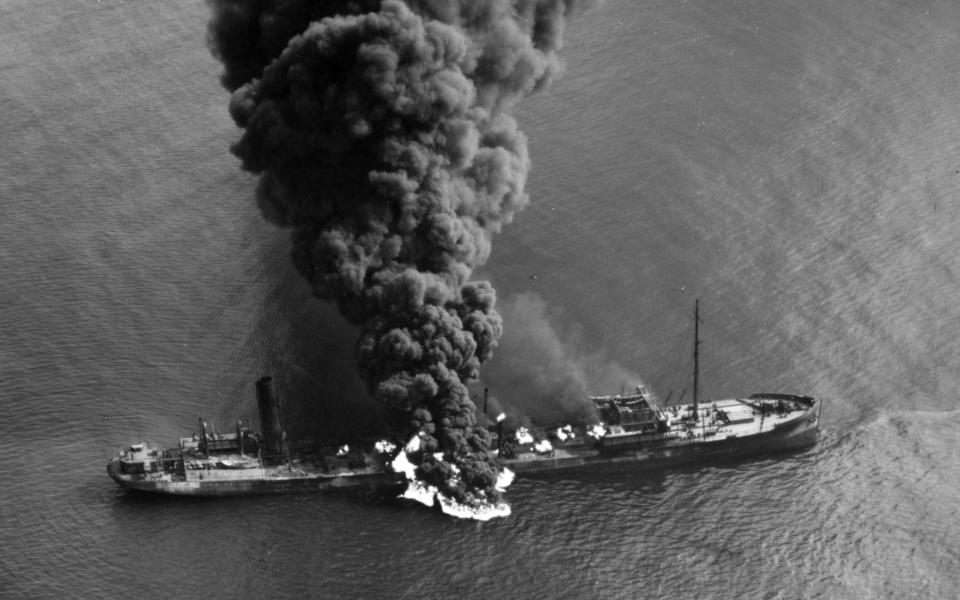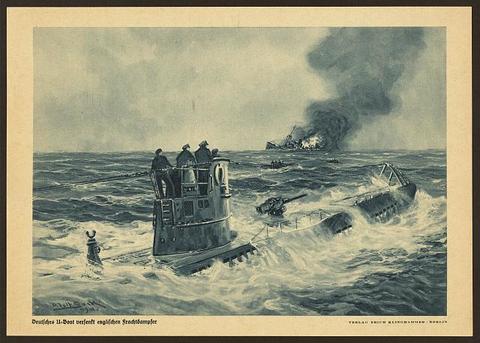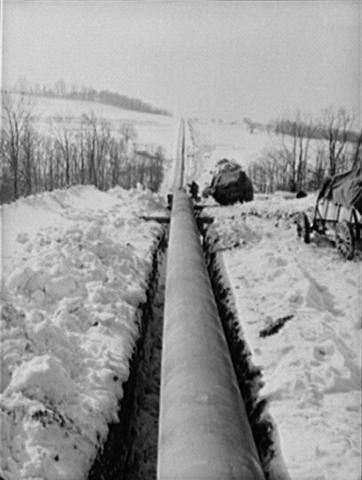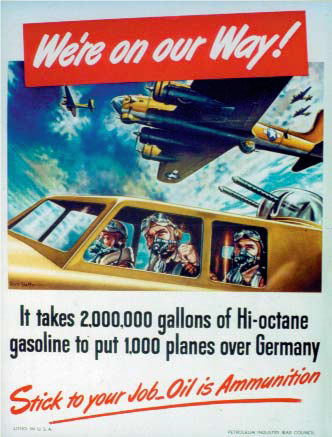Taking Measure
Just a Standard Blog

The tanker Byron D. Benson was torpedoed by a German U-boat while traveling off the coast of North Carolina in April 1942. The ship was delivering crude oil from Texas to New Jersey.
If you drive north from NIST’s Gaithersburg, Maryland, campus, you will soon reach the famed Mason-Dixon Line marking the border between the states of Maryland and Pennsylvania. Continue for just a few more kilometers and you’ll cross over a second historic line: the Inch Line (sometimes called the Inch Lines, for reasons explained below). Contrary to its diminutive name, this line stretches more than 2,000 kilometers (1,200 miles) from Texas to New Jersey. Constructed during World War II, it inspired a quip that illustrates its importance: “The war was won by an Inch.”
The genesis of this line can be traced back to one man and his first job at the National Bureau of Standards (NBS, now called the National Institute of Standards and Technology, or NIST).
William Gillum Heltzel (1895-1959) graduated from the Carnegie Institute of Technology in 1918 and landed his first post-college job that same year in the Electrical Measuring Instruments section at NIST. About a year later, Heltzel headed West to join the oil industry as a pipeline engineer. To his surprise, Heltzel discovered that the accurate measurements he’d become accustomed to at NIST did not yet exist in pipeline work. Pipeline designs of the time were based on imprecise rules of thumb, and Heltzel set about to change that. After a few years of study and experiment, he published a series of articles, beginning in 1926 with “Fluid Flow and Friction in Pipelines” in the Oil & Gas Journal, which introduced a more rational, science-based methodology to designing pipelines.

Heltzel developed some of the earliest usable flow formulas, which are now considered basic to pipeline design. His research enabled the efficient pumping of petroleum through larger-diameter and much longer pipelines than previously possible. But Heltzel’s work didn’t have an immediate impact because there was no economic justification for such large pipelines.
No justification, that is, until the advent of World War II.
The U-Boat Problem
Required to lubricate and fuel planes, tanks and other combat machinery, oil was a key strategic commodity. Because of its tremendous importance, both the Axis and Allies naturally tried to maintain and expand their supplies while cutting off those of their enemy. In that regard, the U.S. had an advantage. At the time, the U.S. produced 60 percent of the world’s crude oil while our primary foe, Nazi Germany, had limited domestic oil production. U.S. oil supplies, however, were far from the battlefield and had to be shipped over thousands of kilometers of ocean to Europe.
Even within the U.S., 95 percent of petroleum products were transported by ocean-going tankers, which carried the precious stuff from the Texas Gulf Coast to refiners and distributors in the industrialized Northeastern states. With Nazi submarines now roaming the Atlantic, the U.S. government realized that the sea shipping routes were vulnerable. Alternatives were needed.

“Building of a crude [oil] pipeline from Texas to the East might not be economically sound,” Secretary of the Interior Harold Ickes wrote to President Roosevelt in July 1940, “but in the event of an emergency it might be absolutely necessary.”
That emergency arrived quickly. The U.S. entered the war in December 1941, and in the month of February 1942 alone, Nazi submarines sunk 12 U.S. oil tankers along the East Coast. To protect the remaining tanker fleet, the government restricted the ships to the trans-Atlantic route, which stretched from the U.S. Northeast to Europe. While still dangerous, this route limited the tankers’ time at sea and allowed them to cross the Atlantic in an easier-to-defend convoy.
To make up for the lost tankers, oil from Texas was sent to the Northeast via trains and river barges. But those means of transport could not replace the large volume of petroleum that had been shipped by sea. By one estimate, East Coast refiners had been receiving 300,000 barrels of oil daily by ship. Trains and barges were only able to deliver a combined 140,000 barrels per day, less than half the previous supply. In the battle over oil, the Nazis had struck a decisive blow.
According to historian Michael Gannon in his book Operation Drumbeat: The Dramatic True Story of Germany’s First U-Boat Attacks Along the American Coast in World War II, “The U-boat assault on merchant shipping in United States waters during 1942 constituted a greater strategic setback for the Allied war effort than the defeat at Pearl Harbor.”
Won by an Inch

To maintain the flow of oil, the government funded the construction of the longest and largest pipeline ever built up to that time. Officially named the War Emergency Pipeline, it passed through 10 states and connected Baytown, Texas, on the Gulf of Mexico, with Linden, New Jersey. The War Emergency Pipeline was actually two pipelines running parallel along the same route: A 24-inch (60-centimeter) diameter pipe carried crude oil while a smaller 20-inch (50-centimeter) line carried refined petroleum products.
By the standards of the time, these pipes were giants. Typical pipelines of the period had diameters of no more than 8 inches (20 centimeters). In industry parlance, pipes with a diameter of more than a foot (30 cm) were called “big inch” pipes. Workers building the 24-inch-diameter War Emergency Pipeline named it “the Big Inch.” The 20-inch line was amusingly dubbed “the Little Big Inch.”
Completed exactly one year after construction began in June 1942, the two pipelines are collectively called the “Inch Lines.” The pipelines delivered more than 500,000 barrels of oil per day for the war effort, and all of it on a land route safe from Nazi submarines.

“Without the prodigious delivery of oil from the U.S.,” stated historian Keith Miller, “this global war [WWII], quite frankly, could never have been won.”
The war was truly won by an Inch.
The construction of a pipeline of sufficient size and length to support the demands of the war effort relied on the earlier metrology work of William Heltzel. In fact, both Heltzel and NIST served as consultants on various aspects of the project.
Upon Heltzel’s death in 1959, a petroleum industry trade publication noted that “No other development in the catalog of pipeline achievements has contributed so much to the industry as [Heltzel’s] concept of rational pipeline design.”
The Inch Lines continued to pump oil after the war and are still in use today. In 1998, the Inch Lines were added to the National Register of Historic Places both for their role in the war effort and as an outstanding engineering achievement.
About the author
Related Posts
Comments
Wow! What a fascinating article. So thankful people like W.G. Heltzel are a part of our heritage here in the good ol' USA. Why in the world are topics such as this not included in the History curriculum of our young people today. At 56 years into my life, this is the first of heard of this story, and so glad I did. Thank you for sharing such an interesting and important part of our History.
P.S. I wonder if Matthew Broderick is related to Heltzel? Look at both of their pictures and you will see why I am asking. :-) Have a Great Day!
Great story, important for people to get a history lesson of the great contributions that American engineers have made. Especially Mr Heltzel from NIST. I’m from Australia and the Americans gave tremendous assistance to Australia New Zealand during the Second World War. Thanks, great post
A very interesting article! It was certainly a very different time, but I am struck by the fact that such a tremendous project was completed in such a short time. The Pentagon was also completed very quickly during that time. Given our current regulatory environment, with its accompanying litigation, it is hard to imagine such accomplishments, whatever the crisis.
Also fascinating is the fact that on April 28 1869, Irish and Chinese workers laid ten miles, fifty six feet of railroad track in one day.!
Ditto everything Tom Said. Fascinating article.
Thank you! An impotant part of history I was totally unaware of. (By the way, the subs didn't 'sunk' the tankers... they 'sank' them).
Nice piece of article, keep up the good work
The Big Inch War Emergency Pipeline was constructed in 3 phases. The terminal was dedicated at Norris City, IL on February 19, 1943. The New York Central Railroad transported the oil east until the lifeline of energy reached Pennsylvania.
WG (Gillum) Heltzel was my mother's first cousin. I was three when he passed away, so I have no recollection of him. However, despite their age difference, my mother had been close to "Cousin" Gillum, as she referred to him. I stumbled across this article after reading a recent column in WorldOil, in which the Inch Pipelines were mentioned as well as the quote from Keith Miller. I still have some letters between them my mother and Cousin Gillum. Because he traveled and worked overseas much of his life, his mailing address was simply, The Drake Hotel, Tulsa, Oklahoma. I'm very happy to have come across this article and I agree with one of the others, this is an American story.
Always fun to hear from family members. You are the second Heltzel relative to contact us. He was born nearby in Ellerslie, MD. There are a few photos of Heltzel at the Tulsa Historical Society (in which he looks strikingly like the comedian/actor Seth MacFarlane.) You can search their photo collection from the Society's web site to see them. Please contact me if you'd like more information about W.G. Heltzel.
My father, George E.MacDonald, graduated as a civil engineer from Brooklyn Polytech Institute Class of 1942 (now under NYU), and was hired right away that June of 1942 to work on the pipeline as a surveyor. My father passed, but my mother has his pix of his crew working their way through the heat and swamps of the South. He enlisted in the war after completion, and served in the Army Corps of Engineering- building airplane runways throughout the Pacific. After the war, back to pipelines, hired by Aramco to survey the Saudia Arabian pipeline.
We British obviously obtained great benefits from the 'Big Inch' in WW2, once the petroleum got to our shores we attempted to pump it under the Channel to France. Initial pipelines were not very successful but later over shorter distances it contributed to the overall effort and combined with the US Army's Petroleum Distribution Companies Pipelines






Very interesting history lesson. Being in the business of Quality Control in the Building Construction and Maintenance Arena, I am fascinated by NIST and follow various aspects of the updates. This story was particularly interesting noting the slang terms used by tradesmen creating the term "the big inch". The building trades and derivations of terms that linger today are fascinating to me. Thank you for the article.